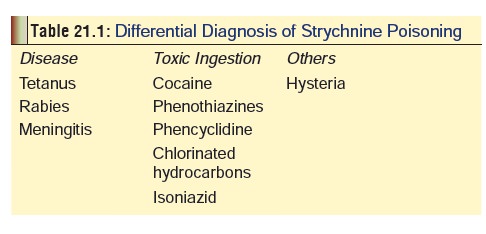Chapter: Modern Medical Toxicology: Neurotoxic Poisons: Spinal and Peripheral Neurotoxic Agents
Strychnine - Spinal and Peripheral Neurotoxic Agents

STRYCHNINE
Strychnine
is the principal alkaloid in the strychnos plant (seeds), and is a powerful
spinal stimulant.
Botanical Name
Strychnos nux vomica.
Other Common Names
Dog
button, Poison nut.
Physical Appearance
·
This is a tree belonging to family
Logianaceae which grows well in South India, as well as in certain other parts
of the country (Fig 21.1).

·
Leaves are oval, dark or variegated
green.
·
Fruits are globular (Fig 21.2) and contain greyish brown
disc-shaped seeds about an inch in diameter and ¼ inch thick, which are
slightly concave on one side and convex on the other (Fig 21.3). The pericarp is very tough. The outer surface is
satin-like due to innumerable fine, silky hairs. While the seeds are odourless,
they are extremely bitter to taste.*


Uses
·
The main alkaloid strychnine has
been in use as a rodenti- cide since the 16th century. It is sometimes used for
killing stray dogs (hence the name “dog buttons”).
·
Strychnine was first used medically
in 1540, and continued to be used in many stimulants, tonics, and cathartics
until as recently as the 1960s.
·
Even today, strychnine is popular in
folk medicine.
Toxic Part
·
Leaves, fruits, and seeds (in
increasing order of toxicity).
Toxic Principle
·
Strychnine and brucine are the
principal alkaloids, of which the former is much more powerful. It is a basic
alkaloid and can be extracted from the seeds as an odourless, bitter-tasting,
white crystalline material.
Mode of Action
·
Strychnine prevents the uptake of
glycine at inhibitory synapses, especially in the ventral horns (anterior horn
cells) of the spinal cord. It results in the competitive antagonism of the
inhibitory neurotransmitter at the post-synaptic spinal cord motor neuron.
There is a net excitatory effect, and minimal sensory stimulation can set off
powerful muscle contractions.
Clinical Features
· A feeling of apprehension and
anxiety is a common prodromal manifestation.
· Muscle twitching, spasms, followed
by overwhelming convulsions (each lasting from 30 seconds to 2 minutes) which
are precipitated by minimal external stimuli.
· Opisthotonus is a characteristic
feature. It is due to powerful extensor spasm causing the body to be
hyperextended with arching of the back (Fig
21.4). Less commonly, empros-thotonus (forward bending) and pleurosthotonus
(lateral bending) are seen.

· Trismus (lockjaw), risus sardonicus (sardonic
smile due to grimacing that results from facial muscle spasm) (Fig 21.5). There may be frothing from
the mouth. Pupils are usually dilated.

· An important diagnostic feature is
that there is complete muscle relaxation in between spasms and convulsions.
· Another feature of significance is that the patient maintains a clear sensorium during and between convulsive episodes.
· Complications include hypoxia,
hyperthermia, cardiac arrest, rhabdomyolysis, metabolic acidosis, and acute
renal failure.
· The usual fatal event is respiratory failure consequent to spasm of respiratory muscles. Prognosis for recovery improves if the patient survives beyond 5 hours.
Differential Diagnosis
Mentioned
in Table 21.1.

Usual Fatal Dose
·
About 30 to 50 mg for strychnine.
·
About 1 to 3 grams for strychnos
seeds.
Diagnosis
·
TLC gives reliable qualitative
results on gastric aspirate, urine, blood, or tissues. The best specimens are
urine and gastric aspirate.
·
HPLC provides accurate quantitative
data.
·
Blood levels in the range of 0.1 to
0.3 mg/100 ml are gener-ally lethal.
Treatment
· Induction of emesis is
contraindicated, since vomiting may precipitate severe convulsive episodes.
· Cautious stomach wash with full
protection of airway may be done in the absence of convulsions. Activated
charcoal should be administered both prior to and following gastric lavage, and
is said to be very beneficial.
· Forced diuresis and dialysis are not
advisable.
· External stimuli should be reduced
to the barest minimum.
·
Treatment should preferably be carried out in a quiet, dark
environment.
· The key to successful management
involves aggressive control of convulsions. Diazepam can be tried first, and
may have to be administered in large doses (up to, or more than 1 mg/ kg). Lorazepam
is a good alternative. If benzodiazepines are ineffective, barbiturates can be
administered (e.g. pentobarbi-tone). Intractable convulsions may necessitate
neuromuscular blockade with pancuronium (0.04 to 0.1 mg/kg).
· Intubation and mechanical ventilation
are invariably necessary.
Autopsy Features
·
Early onset and disappearance of
rigor mortis.
·
Postmortem caloricity.
·
Signs of asphyxia.
·
Frothing at mouth.
·
Dilated pupils
Forensic Issues
·
Strychnine has always had (a mostly
unjustified) reputation of being the homicidal poisoner’s choice for murder.
This myth has been propagated in popular detective fiction by writers such as
Agatha Christie. In reality, strychnine has been uncommonly employed in murder
owing to various obvious reasons: bitter taste, dramatic nature of symptoms
(that will always arouse suspicion of foul play), and easy detectability in
body fluids and tissues. However, occasional cases do get reported from time to
time.
·
Accidental poisoning can result in
children who chew on the seeds out of curiosity while playing or foraging in
the countryside.
·
Previously, therapeutic
misadventures used to be fairly common when strychnine was an approved
constituent of various over-the-counter tonics and cathartics. Even today,
certain indigenous medicinal preparations (including Ayurvedic preparations) do
contain significant concentra- tions of strychnine or brucine.
·
Accidental poisoning can also result
from inadvertent consumption of strychnine-containing rodenticides.
·
Owing to the agonising nature of death,
strychnine is rarely employed in suicide.
Related Topics